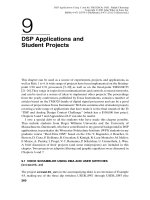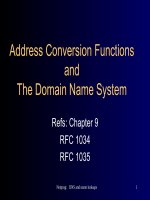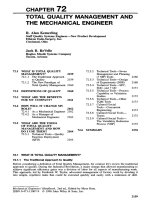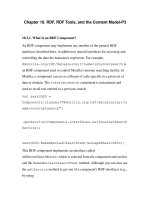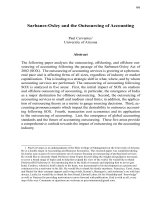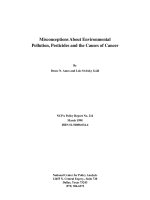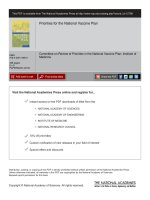Language Assessment and the National Qualifications Framework doc
Bạn đang xem bản rút gọn của tài liệu. Xem và tải ngay bản đầy đủ của tài liệu tại đây (889.13 KB, 120 trang )
HUMAN SCIENCES RESEARCH COUNCIL
INDEPENDENT EXAMINATIONS BOARD
LANGUAGE ASSESSMENT AND THE NATIONAL
QUALIFICATIONS FRAMEWORK
CONFERENCE PROCEEDINGS: 12 OCTOBER 1995
Free download from www.hsrc
p
ress.ac.za
Free download from www.hsrc
p
ress.ac.za
LANGUAGE ASSESSMENT AND THE NATIONAL
QUALIFICATIONS FRAMEWORK
CONFERENCE PROCEEDINGS: 12 OCTOBER 1995
PRETORIA: HSRC
COMPILED AND EDITED BY
MELISSA VIEYRA-KING
KAREN CALTEAUX
HSRC PUBLISHERS
PRETO RIA
1996
Free download from www.hsrc
p
ress.ac.za
© Human Sciences Research Council, 1996
All rights reserved. No part of this publication may be reproduced or transmitted in any form or by any
means, electronic or mechanical, including photocopy, recording or any information storage and retrieval
system, without the permission in writing from the publisher.
ISBN 0-7969-1748-5
Published by:
HSRC Publishers
134 Pretorius Street
PRETORIA
0002
South Africa
Printed by: HSRC Printers
Free download from www.hsrc
p
ress.ac.za
TABLE OF CONTENTS
1 Introductory comments: Language assessment and the NQF
Edward French (IEB) & Ihron Rensburg (Department of
Education) 5
2 The NQF: Challenges in the language field
Schalk Engelbrecht & Gerard Schuring (HSRC) 9
3 Language education and the National Qualifications
Framework: An introduction to competency-based education
and training Daryl McLean (USWE) 15
4 Standards and levels in language assessment
Paul Musker, Sebolelo Nomvete (ELTIC) 63
5 The assessment of language outcomes in ABET:
Implications of an approach
Elizabeth Burroughs, Melissa Vieyra-King, Gabi Witthaus (IEB) 77
6 Issues raised in plenary: Summary
Conference participants 101
7 Summing Up
- Drawing the issues together:
in the context of language education policy
Neville Alexander (PRAESA) 105
8 Summing up -
Drawing the issues together:
in the context of the NQF
Jeanne Gamble (UCT) 107
9 Concluding comments
Chair: Khetsi Lehoko 110
10 List of participants 111
Free download from www.hsrc
p
ress.ac.za
PREAMBLE
Key features of the proposed National Qualifications Framework (NQF), together with the striving for
curriculum renewal, pose a range of tough challenges around the structuring of the assessment of
language development
The aim of the conference was to explore language policy in relation to the NQF proposals and their
implications for implementation of language education for schooling, ABE and training. The conference
was not seen in any way as a policy-setting event, but as a platform for opening up informed debate on
language and the NQF.
Structuring the proceedings
Papers published in these proceedings are primarily discussion documents rather than formal academic
papers. Questions regarding these must please be directed to the authors themselves and not to the
editors. Points raised from the floor in plenary have also been recorded. Because discussions in each
session fended to overlap and cross refer, it was decided to group comments into thematic categories
rather than record them in question-and-answer format in relation to each paper.
Categories for discussion points are as follows:
• Outcomes-based education & training
• Assessment and curriculum
• Language education
• Language paradigms
• The National Qualifications Framework
Melissa Vieyra-King (IEB)
Karen Calteaux (HSRC)
Free download from www.hsrc
p
ress.ac.za
5
INTRODUCTORY COMMENTS:
LANGUAGE ASSESSMENT AND THE NQF
EDWARD FRENCH AND IHORN RENSBURG
Independent Examinations Board and Department of Education
In opening this conference we would like to congratulate you all on your involvement in
an area of concern that is at the heart of national commitments to change and renewal.
For while the subject of this conference may look at first sight like a fairly narrow
professional matter, the conference actually focuses on the challenges of co-ordinating
two of the boldest initiatives in nation building to be adopted by the Government of
National Unity: the National Qualifications Framework (NQF) and the national
language policy of giving equal recognition to the countries eleven major languages.
At present the government is preoccupied with many urgent issues which claim the
public’s attention. Creating jobs and housing and combating crime seems to be the
overarching priorities. Yet it would not be surprising if social historians of the future,
looking back on this momentous decade, were to attribute the creation of a winning
nation to the achievements brought about through the two policy areas which this
conference brings together. This optimistic scenario will depend, of course, on getting
many other things right, and particularly on carrying through the aims and ideals of
qualifications and language policy into effective implementation. At present both areas
of policy offer us great promise. It is up to us to make them work. If you aren’t already
aware of the huge challenges of making them work, there is no doubt that you will be by
the end of today.
The National Qualifications Framework and official language policy share some very
important new features. They are both central to the spirit and intentions of the
Reconstruction and Development Programme. They are both frameworks, based on
extensive participation, consultation and research. Instead of being highly prescriptive
and inflexible sets of laws and rules, they are designed to create unity in a way that
gives great scope for building on the strengths of our diversity. Ideally, different
pathways to development, different local histories, conditions and needs can be
accommodated and nurtured within these frameworks. At the same time systems must
be in place to ensure that national practices and standards are principled and coherent.
Without such systems there would be no way of ensuring a just and developmental
allocation of social and state resources to these fields.
The National Qualifications Framework is both different from and much more than a
streamlined plan for the bureaucratic regulation of education and training in South
Africa. Compared with the scarcely intelligible, incoherent sets of rules, practices and
interests governing qualifications in South Africa at present, the NQF is indeed
Free download from www.hsrc
p
ress.ac.za
6
streamlined. It has an inescapable element of bureaucratic regulation though nothing
like the labyrinth that we have inherited from the past. But above all, it differs from the
past systems which emphasised a punitive, gatekeeping view of qualifications. By
contrast, the NQF aims to use qualifications to open up spaces in which vital, varied,
rich and relevant learning can be recognised, nurtured and linked together across a wide
range of contexts. In short, the NQF is not so much a new system for organising
learning as a new way of understanding and using knowledge in our society.
In the same way national language policy aims to recognise and nurture language
diversity, work against the dominance of certain languages, and promote
communication and learning, personal growth and productivity through different
languages in one national community, using diversity as a resource rather than an
inhibition.
To turn the high aspirations represented by the NQF and language policy into reality is
going to be enormously difficult. The wonderful opportunities, which these new policies
offer, could all too easily turn to dust if they are put into practice in thoughtless ways.
The aims and principles, which underlie them, could be forgotten in the tricky process
of implementation. For this not to happen we need to shed as much light as possible on
the challenges involved.
This is the first conference to begin to look at questions around language policy,
standards and qualifications. The conference is very deliberately aimed at developing
insight and understanding of some of the approaches underlying the NQF. It is not
intended either to come to conclusions about policy or to teach the participants how to
work within a final set of rules, or even to make proposals on language qualifications. If
it tried to do this it would miss the more important stage of developing a high level
conceptual grasp of the implications of the future interaction of the NQF and national
language policy.
The conference has its immediate origins in the Independent Examination Board’s
(IEB) work in the development of outcomes-based assessment for adult education.
Adult education offered an ideal area in which to start working on assessment models
which would give expression to emergent thinking around national standards for
education and training. The field of adult education had operated mainly as non-formal
education. This had created problems in terms of purpose, recognition and coherent
achievement and there was a growing need for a qualifications approach which would
match the contexts, values and innovations of adult education. The advantage of the
situation, compared with formal education, lay in the lack of a complex inherited system
of assessment and qualification.
Three years ago the IEB, drawing on the resources and contributions of a broad array of
stakeholders and role-players, set about designing assessment models and practices for
adult education. To start with they worked only in English. At the beginning of 1995
they started facing the challenges of relating these to a continuum of development in
and across languages. The questions and problems raised by the endeavour were tough,
and the attempts to arrive at working solutions proved intensely controversial. On an
experimental basis the IEB adopted an approach which has been dubbed the ‘common-
outcomes’ approach. In this approach the national standards (outcomes plus assessment
Free download from www.hsrc
p
ress.ac.za
7
criteria) at each level for any language are the same.
The heated debates around this model led to an awareness that there is a long way to go
before the issues which they raise are clarified. The questions involved range well
beyond the boundaries of adult education. They are central to future policy for formal
education at all levels, and they impact on the world of training and on the unfolding of
practices in the new area of the recognition of prior learning (RPL). How far can one
separate curriculum models from assessment models when it comes to language
development, and what is the effect of separating them? How meaningful and useful are
notions like ‘mother-tongue’, ‘foreign’ and ‘other’ language, ‘first, second and third
languages’, ‘language of wider communication’, ‘language for special purposes’,
especially in the peculiar context of South Africa? Even if these notions should be used
in constructing curricula, is the idea of a universal set of assessment stages for language
development useful or not? Should the distinction between ‘learning a language’ and
‘the language of learning’ play an important part in the assessment model as well as in
the curriculum? Can we create a coherent set of national standards for the assessment of
language development without building the contextualisation of that development into
the assessment? If there is an inescapable contradiction here can we anticipate its
consequences, and how might we deal with them? Which policies in terms of all of
these questions will best fit with the highest national education and language policy
goals?
Perhaps the most difficult question of all is the underlying research question: ‘How do
we adequately answer these questions?’ Which questions are amenable to resolution
through prior argument? Which need a decision or a decree? If certain decisions are
taken, how do we ensure that their impact is thoroughly monitored so that we are better
informed for future decisions?
The aim of this conference is to initiate discussion on these kinds of questions. The
issues to be dealt with could easily be spread over a week rather than one day. You will
have done a good job if by the end of today you have clarified and prioritised the key
questions and if you have initiated a much-needed interaction between formal
education, training, adult education and language policy.
We wish you all the best for fruitful deliberations.
Free download from www.hsrc
p
ress.ac.za
8
Free download from www.hsrc
p
ress.ac.za
9
THE NQF: CHALLENGES IN THE LANGUAGE FIELD
SCHALK ENGELBRECHT AND GERARD SCHURING
Human Sciences Research Council
1 INTRODUCTION
On 4 October 1995 the government published the South African Qualifications
Authority Act to provide for the development and implementation of a National
Qualifications Framework and to establish the South African Qualifications Authority.
This ad is based on a report produced by the National Training Board with the tile: A
discussion document on a National Training Strategy Initiative (abbreviated NTSI). The
public debate on the NQF is taken forward in an as yet unpublished report of the HSRC
provisionally titled: Ways of seeing the National Qualifications Framework
(abbreviated WNQF). The act and the two reports show that the NQF will have a
profound influence on the teaching of all subjects, including all the different language
subjects.
The aim of our presentation is to identify and discuss some of the challenges of the NQF
concept for the teaching of language. The first challenge which curriculum developers,
textbook writers and educators face is that they will have to familiarise themselves with
NQF thinking. A second challenge for the stakeholders in language teaching is how to
get started in defining new language learning standards and qualifications. A third and
very important challenge is to find answers to the question of how the different
language units and language qualifications should articulate with one another.
2 SOME SALIENT FEATURES OF NQF THINKING
It is impossible to discuss or explain all the concepts used in NQF thinking in a short
paper. Both reports mentioned earlier are more than 200 pages each. There are many
different aspects and concepts in NQF thinking of which some are difficult: and
complicated. A short discussion of a few concepts will however show that it is very
important for all stakeholders in language teaching to become involved in the NQF
debate.
2 1 Levels and qualifications
The NQF is concerned with formal qualifications and levels of learning. At present a
distinction is made between eight levels. Level 1 is equivalent to Standard 7 and the
name of the qualification for this level may be something like ‘General
Free download from www.hsrc
p
ress.ac.za
10
Education Certificate’. Levels 2, 3 and 4 are equivalent to Standards 8, 9 and 10. A
qualification on Level 4 may be called a ‘Further Education Certificate’. Levels 5 to 8
are reserved for higher certificates, diplomas and degrees. Below Level 1 or Standard 7
several sublevels or grades are recognised. If there are three sublevels for Adult Basic
Education and Training and eight sublevels for formal schooling the language fraternity
of South Africa will have to answer the question if it is possible to distinguish between
16 levels of competence in language use.
2.2 Competence and other concepts
To answer this type of question stakeholders in language learning may have to discuss
whether it is possible in the language-learning field to describe:
!∀ competence in language use as the ability to integrate and apply a range of
capabilities within specified contexts;
!∀ contexts of language use as ranging from being familiar and predictable to
completely unfamiliar and unpredictable;
!∀ performance of language tasks as integrated applications of capabilities within
specified contexts;
!∀ integrated language assessment as assessment of language performance to obtain
evidence of a persons competence in language use;
!∀ a capability as an integrated whole of knowledge, abilities and value orientations;
!∀ the relevant abilities as conceptual language problem-posing and problem-solving,
tool usage and dexterity in language use, communication and social interaction
about language, and modes of learning or familiarity with types of language tasks.
Familiarity with concepts such as these is also necessary because in NQF thinking each
qualification is made up of a number of units of learning, each unit of learning is aimed
at mastering and assessing one or more learning outcomes and each learning outcome is
described in terms of statements on performance, capabilities and assessment.
2.3 Units of learning
A unit of learning is the smallest chunk of learning that can be meaningfully assessed at
a specified level on the National Qualifications Framework. Each unit is registered on a
national register and is assigned a certain credit value or number of points. It may be
possible to equate the credit points to a nominal number of contact hours between
learner and educator. A figure of 40 hours is suggested by some stakeholders. When a
learner has achieved the required number and range of credits and fulfilled possible
other requirements he or she is awarded a national qualification.
Free download from www.hsrc
p
ress.ac.za
11
This means that the stakeholders in language learning will have to develop and register
units of learning for each language on all levels. To describe and develop units of
language learning requires familiarity with a range of concepts including those
mentioned above.
2.4 Misconceptions
There are some misconceptions in this connection. One misconception is that subjects
as such or different types of knowledge are immaterial. In other words, that subjects are
only taught because they are the necessary vehicles for the teaching, demonstration and
assessment of abilities. This is clearly not the aim of the NQF. Both knowledge and
abilities are needed to develop competence. In NQF thinking, knowledge and abilities
are not seen as discrete elements but as dimensions of capabilities and competence. One
may have all the problem-solving or decoding abilities to understand a message in
French, but if one does not know English, one will not be able to decode the content of a
message in English.
Another misconception is that the development of units of language learning is simply
the cutting up and some re-arrangement of the topics in an existing syllabus. We hope
that the discussion up to this point has made it clear that this is certainly not the case.
Instead of ignoring subjects, this demands of the NQF an opportunity to evaluate the
existing language syllabi and to think about what should be included and what should
be excluded on each level of language learning.
3 HOW TO GET STARTED
A second main challenge facing the language-learning stakeholders, is how to start the
development of new language learning units and new language qualifications. The NQF
approach is widely accepted and will be implemented. At present there is still real
opportunity to become involved and to influence the standards which will be set for
language qualifications.
In the report Ways of seeing the National Qualifications Framework, five steps are
suggested to develop the NQF in different fields of learning. The stages are:
(1) The preparation phase
(2) Setting up a National Standards Body
(3) Writing unit standards
(4) Recommending qualifications and moderators
(5) Contextualising learning for specific purposes
Free download from www.hsrc
p
ress.ac.za
12
3.1 The preparation phase
It is suggested that the first step in the preparatory phase is to establish a legitimate co-
ordinating structure for the language field. The appointment of a representative working
group and an acceptable co-ordinator may be necessary to facilitate the smooth running
of activities.
The working group could start by asking questions such as the following:
!∀ What is the context and status of language learning at present?
!∀ What is the purpose of language learning?
!∀ What constitutes competent language performance and how many competence
levels can be identified?
!∀ Is it possible to identify language activities which are indicative of language
capabilities and competent performance?
!∀ Is it possible to identify meaningful levels of progression in language capabilities?
The main aim of these questions is to think about and identify capabilities and
competencies in the language field. The aim is not to draw up a list of discrete tasks or
language topics. The results of this phase will act as an input into the discussion about
standards in a later phase.
3.2 Setting up a National Standards Body
To set standards is a difficult task which differs from field to field. According to the
recently published act, one of the functions of SAQA (the South African Qualifications
Authority) is to formulate and publish policies and criteria for the registration of bodies
responsible for establishing education and training standards or qualifications. The
National Strategy report envisages that these kinds of bodies could replace the existing
Industrial Training Boards. The report Ways of seeing the NQF calls these bodies
National Standards Bodies and anticipates that they will be large, generic bodies which
seek to find coherence, progression and flexibility across a very wide field of learning.
It gives examples of several possible wide bodies, including a body for Communication
Science and Languages. Should a National Standards Body for Communication Science
and Language eventually be established, it will be a bonus for that body if the
communication and language-learning stakeholders had already organised themselves
and made progress in the development of the NQF for their field.
3.3 Writing unit standards
A standard has to be produced for each unit of learning. Writing unit standards is
essentially a process of identifying the capabilities at a specified level of
Free download from www.hsrc
p
ress.ac.za
13
competence. A capability is a unified whole of knowledge and abilities. A unit standard
may include among other things the following five statements:
!∀ A statement on the key capability which the learner is required to demonstrate on
successful completion of the unit. The key capability can be formulated in the
form of a statement such as: Within this area of learning, a competent performer
should be capable of, for example, writing and answering business letters.
!∀ A knowledge statement which can include aspects such as theories, principles and
procedures.
!∀ A statement on the abilities which have to be mastered to achieve real capability.
!∀ A list of performance statements. In other words meaningful activities which
contribute to the overall capability.
!∀ A statement or list of assessment criteria which can be used to demonstrate
capability in successful performance.
3.4 Recommending qualifications and moderators
A qualification is a meaningful clustering of learning units which lay the basis for
further learning. This means that pathways between different units and qualifications
must be created. A qualification may consist of a number of compulsory units and
where applicable also a number of optional units. The body responsible for establishing
qualifications in a wide field and the body responsible for establishing unit standards in
the same field may be one and the same body
Accredited bodies will be responsible for monitoring and auditing achievement in unit
standards and qualifications (Section 5(a) of the act). But it is also necessary to take
steps to ensure compliance with provisions for accreditation and to take steps which will
ensure that standards and registered qualifications are internationally comparable
(Section 5(b) of the act). The people responsible for this type of moderation cannot be
the accredited bodies themselves.
3 5 Contextualising learning for specific purposes
The last step is to develop ways and means which enable individual providers and
private companies to prepare learners for assessment in ways that are appropriate to
their contexts. Learners will also be free to submit themselves for assessment against the
standards set. The important difference between the existing and the NQF approach is
that curriculum prescriptions will be avoided as much as possible and be replaced by the
assessment of the capabilities and competencies which are specified in accessible unit
standards and qualification specifications.
Free download from www.hsrc
p
ress.ac.za
14
4 THE ARTICULATION OF LANGUAGE UNITS AND QUALIFICATIONS
A third challenge is to develop a new system of articulation between all the different
types of language units and qualifications which can be developed in future. In the past
educators have argued for the development of a large number of different types of
language courses. Distinctions were made between first, second and third languages,
between general, applied and basic language courses and between courses presented on
a standard and a higher grade. Finally many other different types of language courses
are presented by institutions and organisations offering courses in Adult Basic
Education and language courses for special purposes.
The development of units for language may reduce some of these distinctions but on the
other hand may also lead to the introduction of many new types of language units. The
problem of how to combine all the different language units in one single system was a
difficult problem in the past and is still difficult to solve.
One avenue, along which a solution is sought, is to select one type of language course
running from the lowest sublevel to the highest level as a standard language course. The
identification of the levels and credit values of all other types of language courses,
language modules and units of language learning can be set in relation to the agreed
standard language course. The course suggested for this purpose is a second language
course. It is also possible and probably better to select the study of a first language in
other words a real or hypothetical mother tongue or home language, as model. Whatever
language course is agreed upon as standard or norm of reference the implication is that
the level assigned to a language unit is not necessarily in direct relation to the historical
year of schooling or language study. A learner presenting one language on level 3 may
for example in the same year present another language on Level 1. The certificate will
probably specify both the levels and the names of the language units studied by the
learner.
5 CONCLUDING REMARKS
It is clear from the arguments presented above that a possible manner of facing the
challenges of the NQF for language teaching and training, is to develop all the units of
language learning for one language from the lowest sublevel to the highest level. It is
suggested that the study of a home language should be selected for this purpose. Once a
complete set of unit standards is developed for one type of language course, the
available set can be used as an example and a benchmark for the development of all
other language courses. The process should allow for continuous re-evaluation and
reformulation of the norm language course.
The development registration and implementation of language learning units will take
time. The sooner the new challenges facing all stakeholders in language learning are
processed and answered by the stakeholders, the better for our children and for the
future of South Africa.
Free download from www.hsrc
p
ress.ac.za
15
LANGUAGE EDUCATION AND THE NATIONAL
QUALIFICATIONS FRAMEWORK: AN INTRODUCTION
TO COMPETENCY-BASED EDUCATION AND TRAINING
DARYL MCLEAN
1
USWE ADULT BASIC EDUCATION PROJECT
1 INTRODUCTION
1.1 The purpose of this paper
The IEB wanted this paper to be written (I think) for two reasons. The first is to help
those people who may want to participate in the current debates about educational
change in South Africa, but who find the jargon and the concepts so bewildering that
they are effectively excluded. I have tried, in this paper, to provide a fairly simple
overview of the issues. However, there are so many issues and each issue is so complex
that I fear (on the one hand) that I have glossed over some of the difficulties and (on the
other hand) that the paper is still not very easy to read.
The second reason why the IEB asked for this paper is that there is a great deal of
confusion in the policy debates, even among those people who are already participating.
I think the IEB hoped that this paper would be able to clarify some of the key issues, for
example by providing a simple answer to the question: What is competency-based
education and training (CBET)?’ But I argue in this paper that CBET is seriously
undertheorised (especially in South Africa), and that much of the confusion in our
policy debates stems from these theoretical inadequacies. Providing an introduction to
the debates (the first goal of this paper) is somewhat at odds with the dense theoretical
work needed to resolve areas of confusion. Consequently, although I have tried at least
to map out where some of the confusion lies, I have for the most part not attempted to
resolve it.
1.2 The structure of this paper
There are four parts to this paper. In the first part, I provide a critical description of
CBET, specifically but not exclusively in relation to South Africa. In the second part, I
sketch some of the recent trends in the theory of language education, which are
pertinent to our consideration of CBET in South Africa. In the third part, I attempt to
link the first and second parts of the paper, focusing specifically on competency-based
language education. In the fourth part, I provide an extensive set of references for
readers interested in pursuing the topic.
Free download from www.hsrc
p
ress.ac.za
16
I have assumed, for purposes of this paper, that my audience is primarily language
educators wanting to learn about CBET, rather than the other way around.
Consequently, Section 2 of the paper is more detailed than the other sections, and
constitutes the bulk of the paper.
2. AN OVERVIEW OF COMPETENCY-BASED EDUCATION AND
TRAINING
2.1 Outline of this section
When I first started reading about CBET, it quickly became evident to me that CBET
was used as a generic label for what were often very different kinds of education and
training. (Much of my paper elaborates on this.) The differences between various forms
of CBET seem to duster around two factors: why it is introduced (i.e. the social
functions of CBET), and how it is introduced (i.e. the forms of curriculum, assessment,
instruction, etc. which CBET takes).
Research into CBET tends to focus either on the ‘why’ factors (sociological research) or
on the ‘how’ factors (‘educational’ issues). I believe that it is crucial not only for us to
consider both sets of factors, but also to integrate our analysis of these factors. As
Jackson has argued:
‘the effect of the competency paradigm is not limited by its power to shape
the practice of individual teachers or the decision-making of individual
institutions. Its impact is also systemic, shaping the various kinds of
regulatory activities through which the state has a voice in the conduct of
education, and through which the educational apparatus reproduces itself’
(1989:83).
The failure of most research to integrate the study of these factors reflects the lack of a
theoretical understanding of what kind of educational phenomenon CBET actually is.
Magnusson & Osborne’s claim (1990:9) that CBET is a ‘technology’ (a configuration of
knowledge and power) is closer to a theoretical formulation than most. But Magnusson
& Osborne have applied a (slightly outdated) theory rather than deriving their theory
from a study of CBET. The lack of an adequate theory as to what constitutes CBET is, I
believe, a major cause of confusion in our debates.
This section of my paper describes the kinds of factors which I think any theory of
CBET should be able to account for. Some of these are what I call ‘why’ factors
(Section 2.2 below); others are what I call ‘how’ factors (Section 2.3 below). Although I
have in this paper not undertaken the task of theorising CBET, I hope that the theory
implicit in my description will provide readers with some of the conceptual tools needed
to engage with current policy proposals.
Free download from www.hsrc
p
ress.ac.za
17
2.2 Why CBET?
In looking at the sociological factors behind the rise of CBET as an educational
movement, I will be describing CBET in four countries in which it is currently very
influential (Section 2.2.1). Then I will refer to four sociological critiques of CBET
(Section 2.2.2). Finally, I will summarise my analysis of these sociological factors
(Section 2.2.3).
2.2.1 A brief history of CBET
2.2.1.1 CBET: THE RISE OF AN EDUCATIONAL REFORM MOVEMENT
CBET has been described as ‘the educational reform movement of the 70’s and 80’s’
(Sheaff s.a.:1):
!∀ In the USA by 1980, more than 70 % of the states had legislated the requirement
of ‘some form of minimum competency testing of students’ (ibid.).
!∀ In the UK, ‘there was patchy and desultory interest in CBET until the early
1980’s, when the basis of a firmer training policy was laid by a series of White
Papers’ (Tuxworth 1989:17). Implemented initially in the vocational training
sector, CBET in the UK is currently being piloted for wider implementation even
in the higher education sector (Burke 1991).
!∀ In Australia, CBET was implemented gradually in the training sector, but ‘became
accepted as an integral part of the national training reform agenda’ in 1990
(Docking 1994:10), and is now central to the government’s vision for
restructuring education and training.
!∀ In South Africa, a form of CBET was widely implemented in the training sector
during the 1980s; but it now appears that (a different form of) CBET will be the
mechanism for integrating and transforming the entire education and training
systems (White Paper 1994).
Jackson, writing in Canada, provides an evocative account of the epidemic which some
Australian educators (Education Links 1992) have called ‘the Competency Can Can’.
She writes that the
competency syndrome has spread much like a socially transmitted disease.
It is communicated not only through the persuasive rhetoric of public
policy, but also through routine contact with administrative and funding
mechanisms which penetrate and organise learning activities in schools,
colleges, social agencies, labour organisations, community groups, and
employer-based training programmes. Whether in literacy programmes,
English as a second language training, adult basic education, skills
upgrading, job re-training the list goes on (1989:78).
Free download from www.hsrc
p
ress.ac.za
18
2.2.1.2 FACTORS BEHIND THE RISE OF CBET INTERNATIONALLY
References to the origins of CBET commonly locate its beginnings in the 1920s, in
ideas of educational reform linked to industrial/business models centered on
specification of outcomes in behavioural objectives form (Tuxworth
1989:11).
The use of behavioural objectives in education and/or training appears to be common in
the history of many countries. However, from the 1960s onward, CBET emerged with
increasing impetus and sophistication on a wide scale. In each case, it appears that the
competency-based approach, while not the reason for change, became the
means by which change could be effected (Docking 1994:10).
Reasons for the introduction of CBET appear to be different in each case.
Accountability and the development of a flexible and more highly skilled workforce
seem to be common factors behind most of the initiatives. For example, within the
USA, CBET was central to attempts to restructure teacher education during the 1960s,
in response to
the demand for greater accountability in education, for increased emphasis
on the economy, and towards more community involvement in decision
making later developments extended applications of the idea to
elementary schools, to minimum competency standards for high school
graduation and to vocational education (ibid.).
In England, on the other hand, although accountability is also a major concern behind
the rise of CBET, the vocationalisation of education is treated in the research literature
as a more important issue. Thus Field (1991:42) describes the English reforms as
therefore the latest refinement in what might be called “the pedagogy of
labour” — that is, the sponsoring of structured and planned learning from
the activity of work, and for work
In Australia, the reforms have been motivated by a perceived need to orient education
and training to the changing nature of the Australian (and world) economy:
The education and training arrangements in Australia are premised on the
labour force needs of an industrial economy: a small minority of
professional workers and highly skilled workers, and a large majority of
unskilled and semi-skilled workers who learn their skills on-the-job; critical
skill gaps have been filled through immigration. Such notions are
dangerously obsolete in the post-industrial OECD economies where high
technology and the service sector are growing in importance - (1968 OECD
report, cited in Docking 1994:9).
Free download from www.hsrc
p
ress.ac.za
19
Many saw competency standards as the vehicle through which employment
and training reforms could be achieved Competency standards were also
seen as a crucial ingredient in the promotion of Australia’s economic and
industrial reform (Chappell 1995:2).
The Australian concerns tend to reflect a more macro-economic vision than the English,
which in both conception and practice have been driven by the needs of particular
industries rather than by a coherent national perspective. Also, accountability seems to
be rather less of an issue in the Australian initiatives than in the North American
movement.
2.2.1.3 FACTORS BEHIND THE RISE OF CBET IN SOUTH AFRICA
In South Africa, factors behind the rise of CBET have been different at different points.
When CBET was implemented in the vocational training sector in the 1980s, it appears
that flexibility and accountability were the dominant concerns. Under the August 1990
amendments to the Manpower Training Act, CBET was a legal requirement on Industry
Training Boards (ITBs), linked as a mechanism of accountability to the simultaneous
devolution of responsibility for training. In a 1992 study conducted for the National
Education Policy Investigation (NEPI), Bennell reported that
[t]he introduction of [competency-based modular training] by ITB’s is
revolutionising training provision right across industry in South Africa.
Some teething problems are being encountered but the obvious benefits of
CBMT are widely recognized by both employers and employees (1992:4).
And also that
The response of [Industry Training Boards] to the introduction of
[competency-based modular training] and criterion referenced instruction
has, with one or two exceptions, been unequivocally positive. Dramatic
improvements in the quality and cost-effectiveness of training at all levels
are widely reported although most industries have yet to complete CBMT
curricula and support materials for all proposed training (1992:9).
Trade unions and employers, partly on the basis of this experience and partly on the
basis of the international trend toward using CBMT as the mechanism for reforming
education and training, adopted competencies as a central feature of the proposed
National Qualifications Framework (NQF). However, the form of CBET which was
introduced in the 1980’s in the vocational training sector is rather different to the form
of CBET currently being proposed for the NQF – something which I suspect is not
widely understood by training programmes which already see themselves as
‘competency-based’. I review some of the educational differences in Section 2.3 of this
paper; but here I would like to focus on differences in the social functions currently
proposed for CBET in South Africa.
Free download from www.hsrc
p
ress.ac.za
20
Presently, both the education and the training systems in South Africa are highly
fragmented. The institutions, curricula and qualifications for education and training
hardly link at all:
! In the education sector in 1993, there were 15 different ministries and 19
organisational departments of education, 129 technical colleges, 103 colleges of
education, 15 technikons and 21 universities (NTB 1993:39).
! In the training sector, ‘there were 9 autonomous Regional Training Centres with
62 satellite campuses and 65 mobile centres. Each Centre had an independent
governing body Private training centres and training centres established by
employers number some 1417 There were separate labour departments in each
of the independent homelands to deal with training for local authorities, the public
sector and some parastatals Industry Training Boards catered for some 26 of the
identified industries [and] there was no single certification body for training’
(ibid.:40-41).
! Not only did the curricula, qualifications, infrastructure, etc. of several categories
of institution not link between the education and training sectors; in many cases
they did not even link within sectors. (For example: technikon curricula and
qualifications did not often link with those of the universities.)
! ‘The legal framework for education and training was set by a range of 130
Statutes (ibid.)
These incoherences in the education and training systems have had a damaging effect
both on the functioning of individuals (who are unable to move within or between
systems) and on the economy and society more broadly (since the human resources of
South Africa cannot be flexibly and efficiently utilised under the current system).
The policy debates around education and training have, for the past five years at least,
therefore agreed on the need to integrate education and training. The mechanism which
has been proposed is a National Qualifications Framework, which will integrate the
systems of provision through first integrating the qualifications structure, and thereby
achieving a ‘washback’ integration of curricula, institutions, etc. Broadly speaking, the
path proposed for the development of the NQF is a process in which
! central government (via the South African Qualifications Authority) will establish
a framework for the NQF which describes the framework and processes for
standard-setting
! National Standards Bodies representative of stakeholders will negotiate the
standards for education and training in a variety of domains (e.g. Communication
Science and Languages; Business, Commerce and Management Sciences, etc.)
Free download from www.hsrc
p
ress.ac.za
21
!∀ Education and Training Qualification Authorities (ETQAs) will be responsible for
ensuring that the standards are adhered to
In order for any education or training course to be accredited, the course will need to
conform to the standards set through these processes. The NQF will thereby achieve an
assessment-led (more accurately, an accreditation-led) reform of the education and
training systems.
Two major concerns provide the impetus behind the NQF in South Africa. First, there is
a concern that our education and training systems should enable the country to become
more economically competitive. Second, there is recognition of the need for redress of
historical inequities resulting from and sedimented in the structure of our education and
training systems. It is common cause that in the debates within the NTB, employers
were primarily concerned about the first of these issues, trade unions with the second.
The principles described by the NTB for the development of the NQF are therefore
intended to embody both these concerns. The NTB (NTB 1993:9-11) believes that the
NQF should aim to achieve
!∀ integration (of education and training)
!∀ relevance (‘to national development needs; industry and service sector needs;
regional, local and community needs; individual development needs and needs
relating to the advancement of knowledge, science and technology. Relevance
refers here to the need for education and training not to be pursued as ends in
themselves, but as a means to achieve other ends, the specific needs listed here’)
!∀ credibility (‘international credibility and credibility for industry and service
sectors, providers and learners in its ability to achieve the nationally agreed aims
for education and training’)
!∀ coherence and flexibility (‘education and training should adhere to a coherent
framework of principles and certification which may be established at national
level, but should permit the flexibility of interpretation required to meet the needs
of industry and service sectors, providers and learners’)
!∀ standards (‘ should be expressed in terms of a nationally agreed framework and
nationally and internationally accepted outcomes’)
!∀ legitimacy (‘education and training should provide for the participation in
planning and co-ordination thereof of all significant stakeholders, to ensure
transparency’)
!∀ access (‘ to appropriate levels of education and training should be provided for
all prospective learners in a manner which facilitates progression’)
!∀ articulation (‘education and training should provide for learners, on successful
completion of accredited prerequisites to move between components of the
delivery system’)
Free download from www.hsrc
p
ress.ac.za
22
!∀ progression (‘education and training should ensure that the framework of
qualifications permits individuals to progress through the levels of national
qualifications via different appropriate combinations of the components of the
delivery system’)
!∀ portability (‘education and training should provide for learners to transfer their
credits or qualifications from one learning institution and/or employer to another’)
!∀ recognition of prior learning (‘education and training should through assessment
give credit to prior learning obtained through formal, non-formal and informal
learning and/or experience’)
!∀ guidance of learners (‘education and training should provide for the guidance of
learners by persons who meet nationally recognised standards for educators and
trainers’).
Economic competitiveness, Within this vision, will be achieved through relevance,
standards, coherence and flexibility, etc. Redress of historical imbalances should be
achieved through the recognition of prior learning, access, portability and mobility, etc.
The link between these two concerns is what distinguishes the NQF from policy
initiatives using CBET elsewhere in the world. As Christie notes:
an important local addition to international debates is the links drawn
between human resource development and equity policies to redress the
apartheid legacy. In this regard, the White Paper builds on the earlier ANC
and Cosatu political platform of “growth through redistribution”, which
links popular demands for social equity with strategies for economic
development. The White Paper interweaves two discourses: alongside a
discourse of human resource development is an ultimately more powerful
discourse of human rights (1995:8).
The entry point of CBET in this vision of the NQF is as the mechanism for setting,
assessing and evaluating the new standards. (It is not — and this is a crucial issue I will
return to later in the paper — necessarily the mechanism for implementing the
standards). The central feature of the standard-setting framework is that the standards
set by every sector for each level would need to be specified in terms of ‘outcomes’
(levels of competence). This is the way in which articulation, portability, access, etc.
can be achieved, as Docking argues of Australia:
The way forward was to end the sharp exclusive demarcation between
professional, skilled and unskilled workers, a demarcation supported by our
approach to education and training, and to develop a workforce that was
‘seamless’ in its skills and an education and training system that reflected
that continuity.
A ‘seamless’ system can be achieved in one of two ways — either remove
all distinctions (clearly unworkable) or increase the number of distinctions
to the point that they are so small that the appearance of seamlessness is
achieved (much as a curve can be drawn by joining a large number of very
Free download from www.hsrc
p
ress.ac.za
23
short straight lines). In the past, competence was only recognised by the
achievement of large inviolable chunks such as degrees (three or more
years) and trade certificates (four years). If we could recognise smaller steps
in achievement that build to these levels of accomplishment, perhaps a
seamless and continuous education and training pathway could be
conceived. To achieve this, we would have to break down our existing
qualifications into their component parts (Docking 1994:9).
The motives behind the introduction of CBET in South Africa presently (the social
functions envisaged for the educational changes) are therefore not exactly the same as
the rationale behind its introduction elsewhere in the world, and are also different to the
earlier functions of CBET in South Africa.
2.2.2 Sociological critiques of CBET
It is worth exploring some of the sociological critiques of CBET (and of the integration
of education and training as the rationale for introducing CBET), since these have not
been widely heard in the South African debates. I have focused below on the critique of
four factors, which I have called accountability, instrumentalism, agency, and
thoughtfulness.
2.2.2.1 THE CRITIQUE OF ACCOUNTABILITY
The introduction of CBET as a mechanism for enforcing accountability has been widely
criticised. Jackson, writing in a Canadian context, describes the competency paradigm
as an ‘invasive power as a system of accountability for educational action’ (1989:82).
Brown argues of Australia that
[t]hese initiatives are not reforms but are rather hegemonic. The defining of
learning and teaching using competencies has embedded within it an
ideology of control intended for the regulation of participants … (1992:26).
And also more bluntly that
… the competency agenda is a strategy for the reform of workers, not
reform for workers … more a strategy aimed at the regulation of variable
capital (ibit.:28).
Post-structuralist analyses of the rise of CBET in England have argued, inter alia, that it
… reflects a fundamental change in the mode of regulation in society
associated with the social control of expertise and the position and
regulation of “experts” as with the surveillance of those who form their
client groups (Jones & Moore 1993:385).
Free download from www.hsrc
p
ress.ac.za
